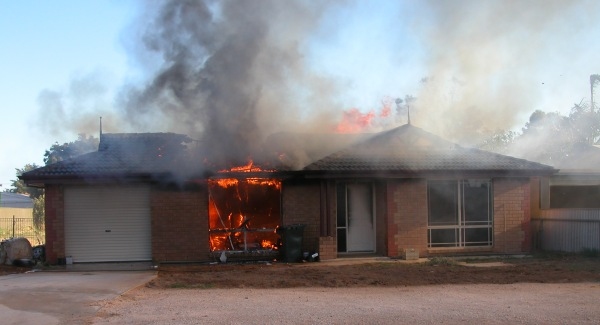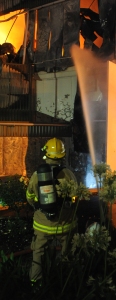
This work is licensed under a Creative Commons Attribution-ShareAlike 4.0 International License

Different Types of Incidents attended by CFS Volunteers

Structure Fires present a unique fire-fighting environment for CFS volunteers. The enclosed environment means that the temperature inside the building is often highly elevated (well above 400°C), the smoke is often very toxic, and visibility is limited.
 During each year, approximately 5% of the calls attended by the CFS are structure related.
During each year, approximately 5% of the calls attended by the CFS are structure related.
Because the smoke generated in a Structure fire is generally toxic, firefighters use Compressed Air Breathing Apparatus (CABA, or just BA). A BA set is similar to a SCUBA set used underwater, and consists of an air tank, connected to a mask. The current Draeger BA sets, utilised by the CFS, weigh approx 13 kg.
On arrival, firefighters must quickly ascertain the condition of the structure, whether any persons are still inside the building and where they may be. Other hazards such as electricity and gas supplies, and building contents need to be identified as early as possible. Munitions and chemicals present special hazards that need to be dealt with appropriately. The surrounding exposures, such as other buildings or vehicles may also need protection.
The firefighters will then enter the building to perform a search for missing persons and the location of the fire. Every room, cupboard and cavity needs to be thoroughly searched, and any trapped persons removed as quickly as possible.
An Entry Control Officer (ECO) monitors the BA operator's entry and exit from a burning structure. Generally each firefighter has approximately 30 working minutes per cylinder of air, with a ten minute reserve, when working hard.
In many situations, the fire itself is quite small, but generates large quantities of thick, toxic smoke. Firefighters working outside the burning structure often set up a Positive Pressure Ventilation fan (PPV fan), powered by either a petrol engine or water. The fan is placed at an entrance to the building, and an exit point at the opposite end of the structure is opened. The fan then blows much of the smoke out which allows firefighters to see where the fire is quickly and extinguish it with a small amount of water, thereby limiting damage to the structure and its contents from water.
Photographs on this page taken by the CFS Promotions Unit






